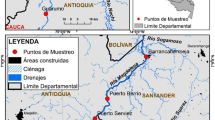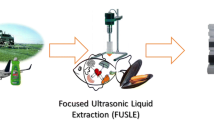Abstract
The composition of Atlantic salmon feed has changed considerably over the last two decades from being marine-based (fishmeal and fish oil) to mainly containing plant ingredients. Consequently, concern related to traditional persistent contaminants typically associated with fish-based feed has been replaced by other potential contaminants not previously associated with salmon farming. This is the case for many pesticides, which are used worldwide to increase food production, and may be present in plant ingredients. Earlier studies have identified two organophosphorus pesticides, chlorpyrifos-methyl and pirimiphos-methyl, in plant ingredients used for aquafeed production. In the present study, we developed a reliable and sensitive analytical method, based on liquid chromatography coupled to tandem mass spectrometry, for the determination of these pesticides and their main metabolites in warm water (zebrafish) and cold water (Atlantic salmon) species, where possible differences in metabolites could be expected. The method was tested in whole zebrafish and in different salmon tissues, such as muscle, bile, kidney, fat, and liver. The final objective of this work was to assess kinetics of chlorpyrifos-methyl and pirimiphos-methyl and their main metabolites in fish tissue, in order to fill the knowledge gaps on these metabolites in fish tissues when fed over prolonged time.




Similar content being viewed by others
References
Shepherd CJ, Jackson AJ. Global fishmeal and fish-oil supply: inputs, outputs and marketsa. J Fish Biol. 2013;83:1046–66. https://doi.org/10.1111/jfb.12224.
Ytrestøyl T, Aas TS, Åsgård T. Resource utilisation of Norwegian salmon farming in 2012 and 2013. Nofima Report. 2014;34. https://nofima.no.
Berntssen MHG, Lundebye A-K, Torstensen BE. Reducing the levels of dioxins and dioxin-like PCBs in farmed Atlantic salmon by substitution of fish oil with vegetable oil in the feed. Aquac Nutr. 2005;11:219–31. https://doi.org/10.1111/j.1365-2095.2005.00345.x.
Berntssen MHG, Julshamn K, Lundebye A-K. Chemical contaminants in aquafeeds and Atlantic salmon (Salmo salar) following the use of traditional- versus alternative feed ingredients. Chemosphere. 2010;78:637–46. https://doi.org/10.1016/j.chemosphere.2009.12.021.
Nácher-Mestre J, Serrano R, Portolés T, Berntssen MHG, Pérez-Sánchez J, Hernández F. Screening of pesticides and polycyclic aromatic hydrocarbons in feeds and fish tissues by gas chromatography coupled to high-resolution mass spectrometry using atmospheric pressure chemical ionization. J Agric Food Chem. 2014;62:2165–74. https://doi.org/10.1021/jf405366n.
Kaczyński P, Łozowicka B, Perkowski M, Szabuńko J. Multiclass pesticide residue analysis in fish muscle and liver on one-step extraction-cleanup strategy coupled with liquid chromatography tandem mass spectrometry. Ecotoxicol Environ Saf. 2017;138:179–89. https://doi.org/10.1016/j.ecoenv.2016.12.040.
Belenguer V, Martinez-Capel F, Masiá A, Picó Y. Patterns of presence and concentration of pesticides in fish and waters of the júcar river (eastern Spain). J Hazard Mater. 2014;265:271–9. https://doi.org/10.1016/j.jhazmat.2013.11.016.
Zhang H, Wang J, Li L, Wang Y. Determination of 103 pesticides and their main metabolites in animal origin food by QuEChERS and liquid chromatography–tandem mass spectrometry. Food Anal Methods. 2017;10:1826–43. https://doi.org/10.1007/s12161-016-0736-7.
Gan J, Lv L, Peng J, Li J, Xiong Z, Chen D, et al. Multi-residue method for the determination of organofluorine pesticides in fish tissue by liquid chromatography triple quadrupole tandem mass spectrometry. Food Chem. 2016;207:195–204. https://doi.org/10.1016/j.foodchem.2016.02.098.
Botero-Coy AM, Marín JM, Serrano R, Sancho JV, Hernández F. Exploring matrix effects in liquid chromatography-tandem mass spectrometry determination of pesticide residues in tropical fruits. Anal Bioanal Chem. 2015;407:3667–81. https://doi.org/10.1007/s00216-015-8586-5.
Portolés T, Ibáñez M, Garlito B, Nácher-Mestre J, Karalazos V, Silva J, et al. Comprehensive strategy for pesticide residue analysis through the production cycle of gilthead sea bream and Atlantic salmon. Chemosphere. 2017;179:242–53. https://doi.org/10.1016/j.chemosphere.2017.03.099.
VKM. Benefit-risk assessment of fish and fish products in the Norwegian diet – an update. Scientific Opinion of the Scientific Steering Committee. VKM Report. 2014;293. https://www.vkm.no.
Rao JV, Rani CHS, Kavitha P, Rao RN, Madhavendra SS. Toxicity of chlorpyrifos to the fish Oreochromis mossambicus. Bull Environ Contam Toxicol. 2003;70:985–92. https://doi.org/10.1007/s00128-003-0079-0.
European Food Safety. Modification of the existing MRLs for chlorpyrifos-methyl in various crops. EFSA J. 2011;9(6):2219. https://doi.org/10.2903/j.efsa.2011.2219.
European Commission. Review report for the active substance chlorpyrifos-methyl. 2015. https://www.ec.europa.eu/food/plant/pesticides/eupesticides-database/public.
EFSA (European Food Safety Authority). Reasoned opinion on the review of the existing maximum residue levels (MRLs) for pirimiphos-methyl according to Article 12 of Regulation (EC) No 396/2005. EFSA J. 2015;13:3974. https://doi.org/10.2903/j.efsa.2015.3983.
SANTE/11813/2017. Guidance document on analytical quality control and validation procedures for pesticide residues analysis in food and feed. 2017. https://www.ec.europa.eu/food/plant/pesticides/max_residue_levels/guidelines_en.
Acknowledgments
The authors wish to thank the staff at the Skretting ARC, Lerang Research Station for their excellent help with sampling and conducting the feeding trial. Tania Portolés acknowledges Ramon y Cajal Program from the Ministry of Economy and Competitiveness (RYC-2017-22525) for funding her research.
Funding
The present work was financed by the Norwegian Research Council (NFR) project “AQUASAFE” (254807).
Author information
Authors and Affiliations
Corresponding authors
Ethics declarations
Conflict of interest
The authors declare that there is no conflict of interest.
Research involving animals
The experiment complied with the guidelines of the Norwegian Regulation on Animal Experimentation and EC Directive 86/609/EEC. The National Animal Research Authority approved the protocol (ID 12091).
Additional information
Publisher’s note
Springer Nature remains neutral with regard to jurisdictional claims in published maps and institutional affiliations.
Electronic supplementary material
ESM 1
(PDF 98 kb)
Rights and permissions
About this article
Cite this article
Garlito, B., Ibáñez, M., Portolés, T. et al. LC-MS/MS method for the determination of organophosphorus pesticides and their metabolites in salmon and zebrafish fed with plant-based feed ingredients. Anal Bioanal Chem 411, 7281–7291 (2019). https://doi.org/10.1007/s00216-019-02104-6
Received:
Revised:
Accepted:
Published:
Issue Date:
DOI: https://doi.org/10.1007/s00216-019-02104-6




